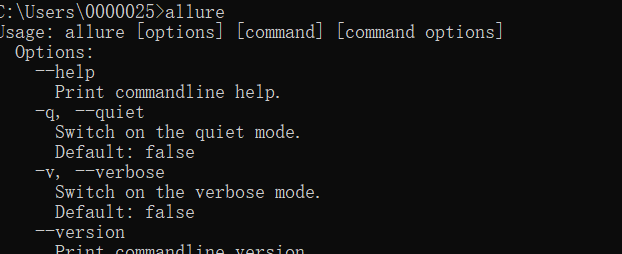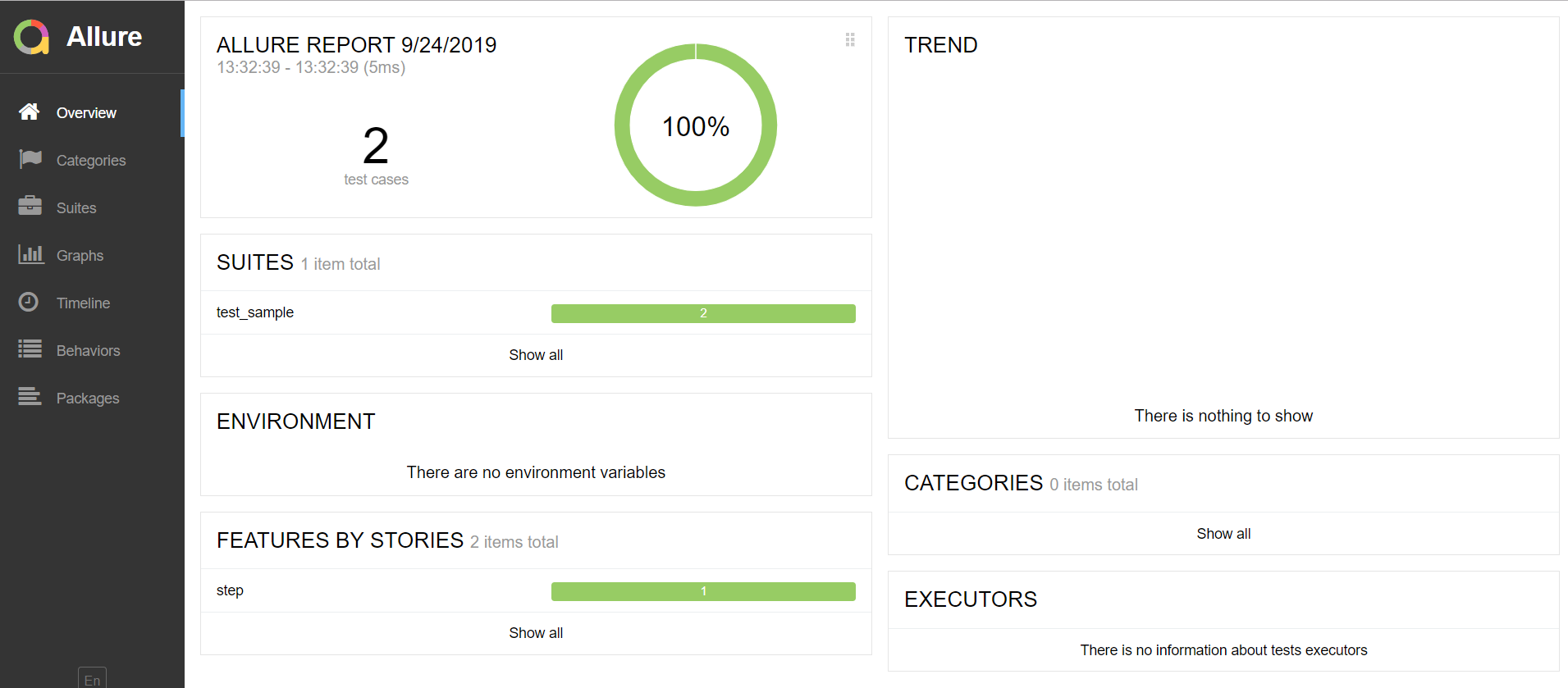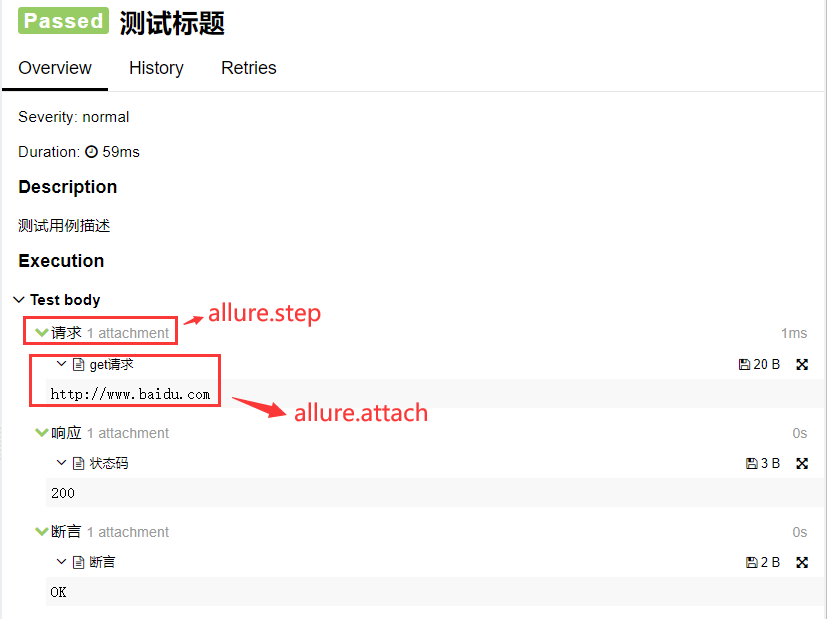Allure+pytest 生成测试报告
简介:
python 主流自动化测试报告插件有三个:HTMLTestRunner、BeautifulReport 和 Allure。HTMLTestRunner是一个比较古老的报告模板,界面也不是很好看。BeautifulReport 界面很简洁,看起来也很直观,是一款比较不错的报告插件。如果你想提升一下你的level,让你的自动化测试报告变得高大上,那么请选择 Allure 。
Allure 是一款轻量级的开源自动化测试报告生成框架。它支持绝大部分测试框架,比如 TestNG、Junit 、pytest、unittest 等。本文主要介绍 pytest 框架结合 Allure 生成 格式统一、美观的 测试报告。
1.Allure 下载安装
Allure 下载最新版本:https://github.com/allure-framework/allure2/releases
下载完成之后,解压到 pytest 目录中。然后设置环境变量,简单一点就是进入 \allure-2.13.0\bin 目录执行 allure.bat 。cmd 输入 allure 查看环境变量是否设置成功。

2. allure-pytest
下载 allure-pytest 插件,用来生成 Allure 测试报告所需要的数据。
pip3 install allure-pytest
案例分析:
1、编写一段使用 pytest 框架的测试代码:
#!/usr/bin/env python # coding=utf-8 import pytest import allure import os @pytest.fixture(scope='function') def login(): print("登录") yield print("登录完成") @allure.feature('加入购物车') def test_1(login): '''将苹果加入购物车''' print("测试用例1") @allure.feature('加入购物车') def test_2(): '''将橘子加入购物车''' print("测试用例2") if __name__ =="__main__": # 执行pytest单元测试,生成 Allure 报告需要的数据存在 /temp 目录 pytest.main(['--alluredir', './temp']) # 执行命令 allure generate ./temp -o ./report --clean ,生成测试报告 os.system('allure generate ./temp -o ./report --clean')
2、执行后生成 Allure 报告:

打开 index.html ,测试报告如下:

3、@allure 装饰器中的一些功能点:
1)想对你的用例集分层,增加可读性,可以使用以下三个装饰器,写在类或方法前面:
- @allure.epic :敏捷里的概念,定义史诗
- @allure.feature :用于定义被测试的功能,被测产品的需求点
- @allure.story : 用于定义被测功能的用户场景,即子功能点
#!/usr/bin/env python # coding=utf-8 import pytest import allure import os @pytest.fixture(scope='function') def login(): print("登录") yield print("登录完成") @allure.epic('这是一个测试') @allure.feature('购物车') @allure.story('加购商品') def test(login): '''将苹果加入购物车''' print("测试用例") if __name__ =="__main__": # 执行pytest单元测试,生成 Allure 报告需要的数据存在 /temp 目录 pytest.main(['--alluredir', './temp']) # 执行命令 allure generate ./temp -o ./report --clean ,生成测试报告 os.system('allure generate ./temp -o ./report --clean')

2)想对单个用例添加标题和用例描述,增加可读性,使用以下两个装饰器:
- @allure.description :添加测试用例描述,参数类型为str,与使用''' '''效果类似。如果想传html,请使用 @allure.description_html
- @allure.title :修改单个测试用例标题,支持传递关键字参数
#!/usr/bin/env python # coding=utf-8 import pytest import allure import os path = os.path.join(os.path.abspath('').replace('testcase','testcase_data\\excel'),'order.xlsx') data_test_order_balance = Readexcel.readrows(path,'test_order_balance') @allure.description('测试用例描述') @allure.title('参数:{phone},{password},{money}') @pytest.mark.parametrize('case,cityflag,phone,password,money,sourcetype,products,code', data_test_order_balance) def test(case,cityflag,phone,password,money,sourcetype,products,code): print("测试用例") if __name__ =="__main__": # 执行pytest单元测试,生成 Allure 报告需要的数据存在 /temp 目录 pytest.main(['--alluredir', './temp']) # 执行命令 allure generate ./temp -o ./report --clean ,生成测试报告 os.system('allure generate ./temp -o ./report --clean')

3)动态生成功能,以下方法都支持动态生成,也可以覆盖装饰器 @allure 的内容
- allure.dynamic.feature
- allure.dynamic.link
- allure.dynamic.issue
- allure.dynamic.testcase
- allure.dynamic.story
- allure.dynamic.title
- allure.dynamic.description
#!/usr/bin/env python # coding=utf-8 import pytest import allure import os @allure.description('测试用例描述') @allure.title('测试标题') def test(): allure.dynamic.description('动态描述') allure.dynamic.title('动态标题') print("测试用例") if __name__ =="__main__": # 执行pytest单元测试,生成 Allure 报告需要的数据存在 /temp 目录 pytest.main(['--alluredir', './temp']) # 执行命令 allure generate ./temp -o ./report --clean ,生成测试报告 os.system('allure generate ./temp -o ./report --clean')

4)如果想对每个测试用例进行非常详细的步骤信息说明,提高可读性,可以使用以下两个方法:
- allure.step :对每个测试用例进行步骤说明
- allure.attach :输出内容
先看下 allure.attach(body, name=None, attachment_type=None, extension=None) 定义,参数如下
- body:要显示的内容(附件)
- name:附件名字
- attachment_type:附件类型,是 allure.attachment_type 里面的其中一种
- extension:附件的扩展名
也可以使用文件路径:allure.attach.file( source, body, name=None, attachment_type=None, extension=None),source为文件路径,其他参数和上述一致
#!/usr/bin/env python
# coding=utf-8
import pytest,allure,os,requests
@allure.description('测试用例描述')
@allure.title('测试标题')
def test():
url = 'http://www.baidu.com'
h = requests.get(url=url)
with allure.step('请求'):
allure.attach('{}'.format(url),name='get请求',attachment_type = allure.attachment_type.TXT)
with allure.step('响应'):
allure.attach('{}'.format(h.status_code),name='状态码',attachment_type = allure.attachment_type.JSON)
with allure.step('断言'):
assert h.status_code == 200
allure.attach('OK',name='断言',attachment_type = allure.attachment_type.TXT)
if __name__ =="__main__":
# 执行pytest单元测试,生成 Allure 报告需要的数据存在 /temp 目录
pytest.main(['--alluredir', './temp'])
# 执行命令 allure generate ./temp -o ./report --clean ,生成测试报告
os.system('allure generate ./temp -o ./report --clean')






【推荐】国内首个AI IDE,深度理解中文开发场景,立即下载体验Trae
【推荐】编程新体验,更懂你的AI,立即体验豆包MarsCode编程助手
【推荐】抖音旗下AI助手豆包,你的智能百科全书,全免费不限次数
【推荐】轻量又高性能的 SSH 工具 IShell:AI 加持,快人一步
· 从 HTTP 原因短语缺失研究 HTTP/2 和 HTTP/3 的设计差异
· AI与.NET技术实操系列:向量存储与相似性搜索在 .NET 中的实现
· 基于Microsoft.Extensions.AI核心库实现RAG应用
· Linux系列:如何用heaptrack跟踪.NET程序的非托管内存泄露
· 开发者必知的日志记录最佳实践
· winform 绘制太阳,地球,月球 运作规律
· AI与.NET技术实操系列(五):向量存储与相似性搜索在 .NET 中的实现
· 超详细:普通电脑也行Windows部署deepseek R1训练数据并当服务器共享给他人
· 【硬核科普】Trae如何「偷看」你的代码?零基础破解AI编程运行原理
· 上周热点回顾(3.3-3.9)
2018-09-27 python日志模块